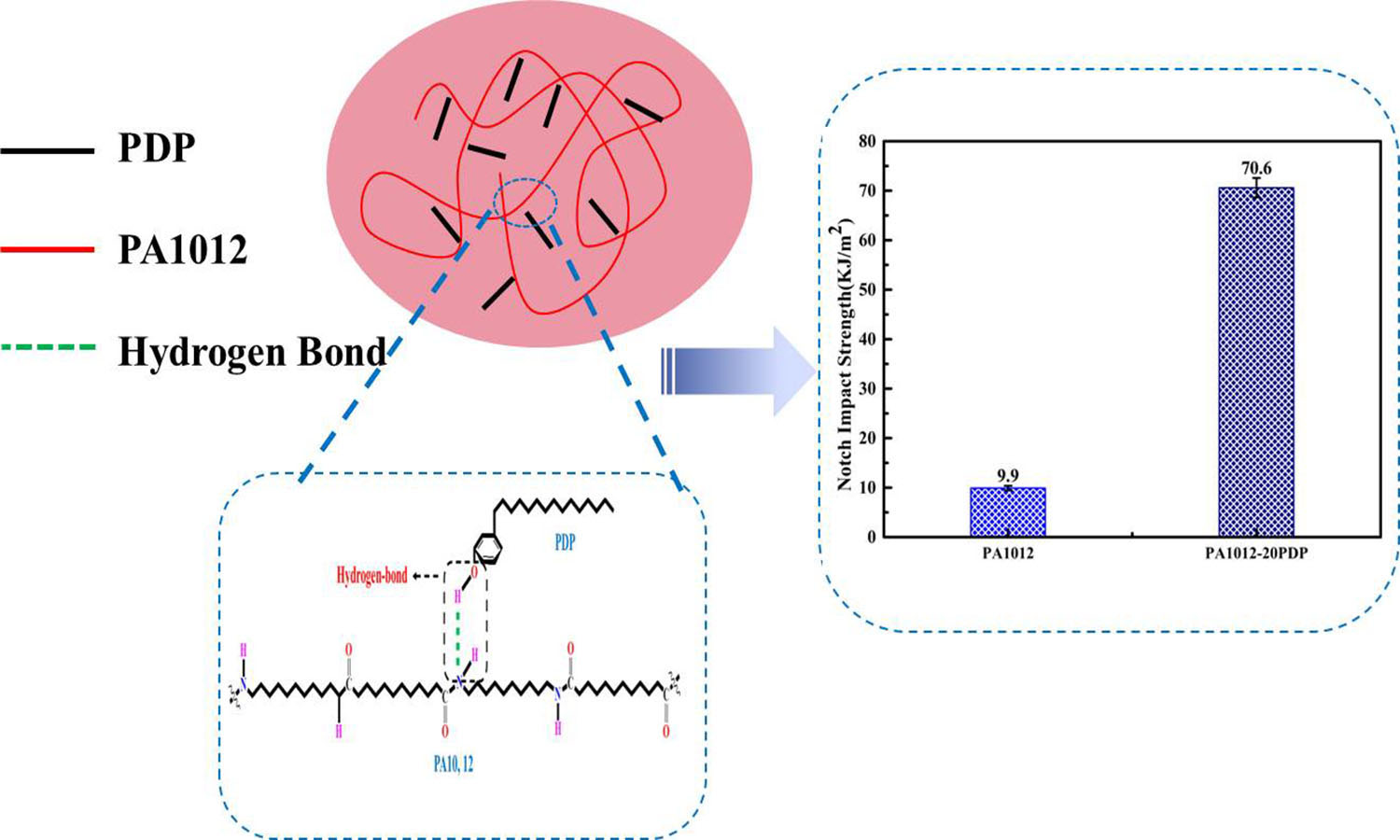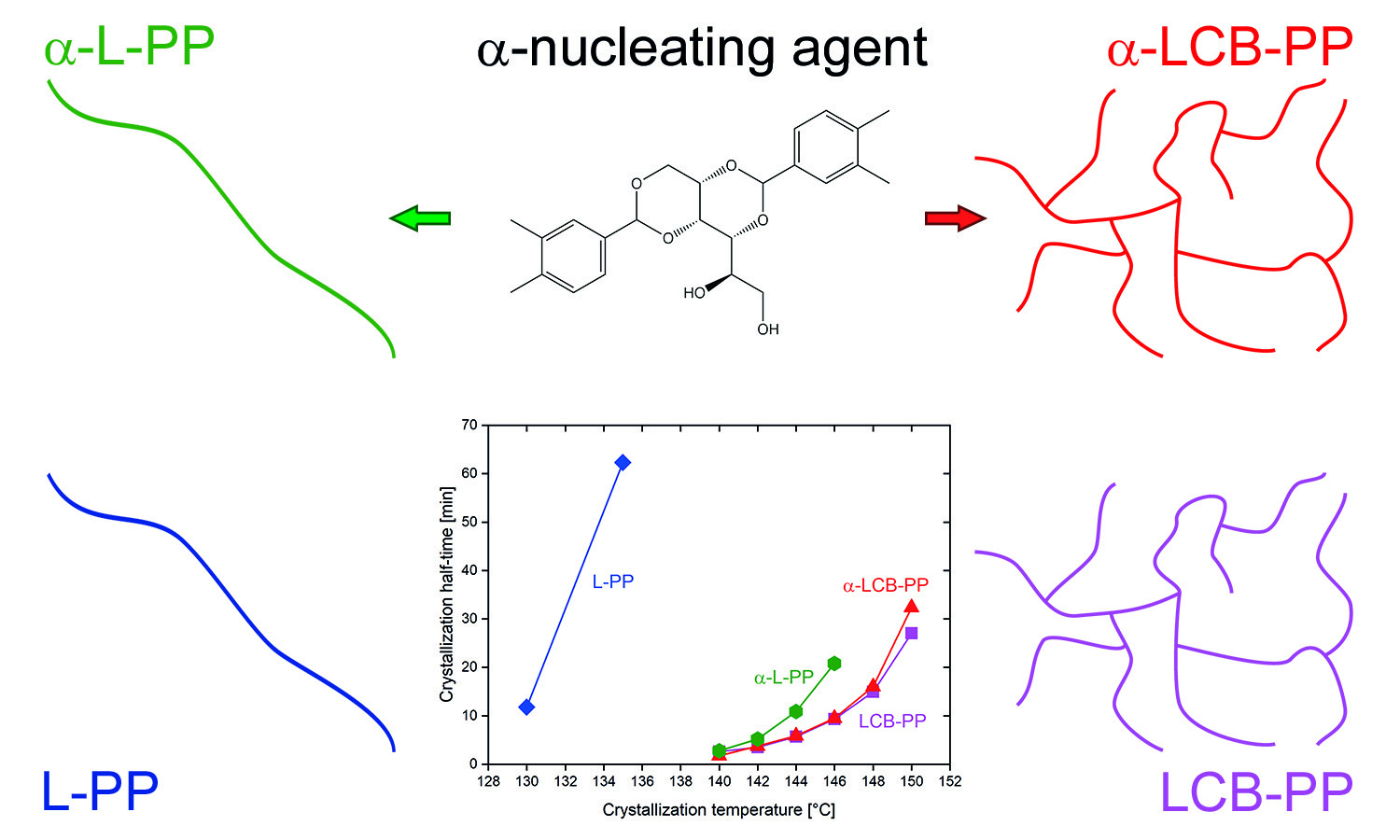Toughness enhancement of polyamide 1012 with intermolecular hydrogen bonding with 3-pentadecylphenol
Jing Lu, Qin Ma, Jianqi Yao, Jiajie Yin, Ruiyan Zhang, Faliang Luo
Vol. 18., No.7., Pages 705-714, 2024
DOI: 10.3144/expresspolymlett.2024.52
DOI: 10.3144/expresspolymlett.2024.52
GRAPHICAL ABSTRACT

ABSTRACT
In order to improve the impact toughness of polyamide 1012 (PA1012) by reducing the amount of hydrogen bonding resulting from PA1012 itself, 3-pentadecylphenol (PDP) was considered to be added into PA1012 using melting extrusion. The hydrogen bonding interaction between PA1012 and PDP was characterized by Fourier transform infrared spectroscopy (FTIR) and nuclear magnetic resonance (NMR). The effects of PDP on the crystallization, melting process, and mechanical behavior of PA1012 were tested in detail. The results show that the PDP can reduce the temperature of PA1012 crystallization and melting but it can significantly improve elongation at break and impact toughness. The notched impact strength of the PA1012/PDP composites containing 20 wt% PDP reached to 70.6 kJ·m–2, which is about seven times that of the neat PA1012. The effects of PDP on PA1012 properties is ascribed to hydrogen bonding interaction between hydrogen bonding between phenol hydroxyl groups and amino groups on PA1012 chains. The deduction was also verified by adding acetylated 3-pentadecylphenol (APDP) to modify PA1012. It is believed the research will open up new prospects for the wide application of PA1012 toughening.
RELATED ARTICLES
Dazhi Zhu, Junhao Wang, Yongheng Sun, Jianqiang Chu, Zhaobo Wang
Vol. 19., No.4., Pages 361-371, 2025
DOI: 10.3144/expresspolymlett.2025.27
Vol. 19., No.4., Pages 361-371, 2025
DOI: 10.3144/expresspolymlett.2025.27

In this research, heat-triggered triple-shape memory polymers (TSMPs) based on the ethylene-methyl acrylate copolymer (EMA)/chloroprene rubber (CR) thermoplastic vulcanizates (TPVs) were prepared by dynamic vulcanization successfully; meanwhile, an effective and facile triple-shape memory strategy was designed to realize the efficient and stable shape fixity and recovery of two temporary shapes. The field-emission scanning electron microscope images showed that EMA/CR TPV surface was a sea-island structure with the CR particle size ranging from 3 to 6 μm. Differential scanning calorimeters and X-ray diffraction were used to investigate the crystallization behavior of both EMA and CR. These served as a significant basis for the two temporary shapes: fixity and recovery. The results of triple-shape memory tests showed that the EMA/CR TPV had excellent triple-shape memory properties, where the first shape fixity ratio was higher than 89% and both the first shape recovery ratio and second shape recovery ratio could be higher than 95%. It can be observed that the EMA/CR TPV exhibited rapid shape recovery speed with the first shape recovery time of 10 s and the second shape recovery time of 20 s, respectively. This research presents a novel approach to extending the application of TPV in the field of smart devices, endowing them with excellent mechanical and triple-shape memory properties.
Sona Zenzingerova, Michal Kudlacek, Jana Navratilova, Lenka Gajzlerova, David Jaska, Lubomir Benicek, Roman Cermak
Vol. 17., No.11., Pages 1110-1120, 2023
DOI: 10.3144/expresspolymlett.2023.84
Vol. 17., No.11., Pages 1110-1120, 2023
DOI: 10.3144/expresspolymlett.2023.84

The
main purpose of this work is to present the effect of long-chain branching and
specific α-nucleation on the optical properties, crystallization and
supermolecular structure of polypropylene (PP). Commercially available α-nucleating/clarifying
agent 1,3;2,4-bis(3,4-dimethylbenzylidene)sorbitol (Millad 3988) was mixed into
linear PP and long-chain branched PP (LCB-PP) in the concentration of 0.2 wt%.
For the study of polymorphic composition, crystallinity, and crystallization process
under isothermal conditions in the temperature range of 130–150 °C,
differential scanning calorimetry and wide-angle X-ray scattering were used.
Although the used nucleating/clarifying agent appears to have a slight effect
on the optical properties of long-chain branched polypropylene, it does not
appear to affect the crystallization kinetics significantly. LCB-PP exhibited
self-nucleation, favored over nucleation by a specific nucleating agent.



